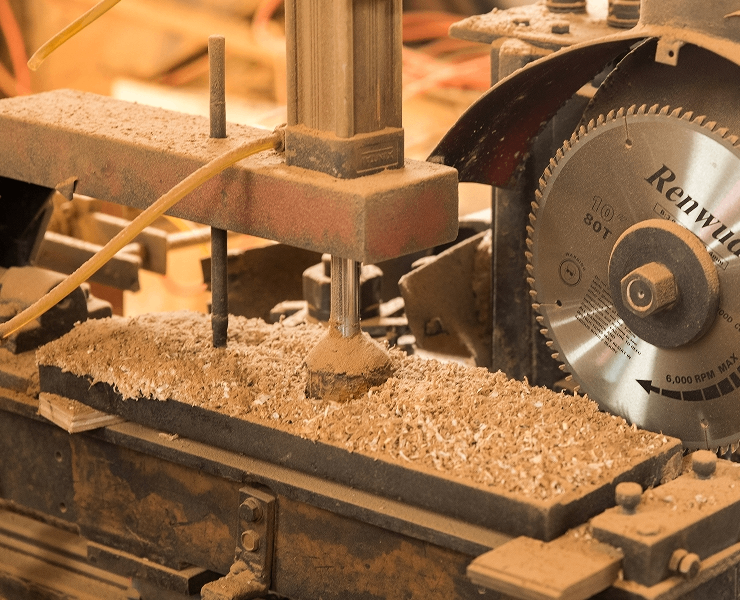In 2024, China's artificial board industry has been steadily advancing amidst a complex and ever-changing market environment, presenting a series of new characteristics and trends in various aspects such as industrial structure, market supply and demand, and technological innovation.
Image Source:699pic
The average production capacity of enterprises rose to about 36,700 cubic meters per year per enterprise. In terms of the industrial pattern, Guangxi with 1,420 enterprises and a production capacity of about 73.2 million cubic meters per year, accounting for 33.1% of the national total production capacity, firmly ranked first in the country. Shandong Province, with 1,680 enterprises and a production capacity of about 53.6 million cubic meters per year, accounting for 24.3%, ranked second. Jiangsu Province, with 920 enterprises and a production capacity of about 26.6 million cubic meters per year, accounting for 12.0%, ranked third. At the same time, the industrial concentration of the plywood industry has increased. There were 497 plywood product production enterprises in the country with an annual production capacity of over 100,000 cubic meters, among which there were 167 large production enterprises and enterprise groups, with a combined production capacity of 36.41 million cubic meters per year, accounting for about 16.5% of the total production capacity.
The particleboard industry continued to expand in 2024, and its total production capacity further increased. Although there was a risk of an imbalance between supply and demand due to excessive investment in the industry during this period, its market share continued to expand gradually due to its outstanding environmental performance. Although the relevant data for the end of 2024 have not been fully disclosed, judging from the development trend in previous years and the situation of ongoing construction projects, the production capacity of particleboard is highly likely to exceed the 52.69 million cubic meters per year in 2023. In terms of production technology, the application of continuous flat pressing technology has become more widespread, and multi-layer presses have also been continuously upgraded. For example, the application of simultaneous closing devices has improved production efficiency.
The fiberboard industry, on the other hand, showed a contracting trend. The average single-line production capacity increased to 158,000 cubic meters per year. Shandong, Guangxi, and Jiangsu ranked among the top three in terms of production capacity. However, with the adjustment of the industrial structure, its supply capacity and consumer demand are gradually approaching a basic balance.
In terms of market supply and demand, the total output of artificial boards in China in 2024 was approximately 371.24 million cubic meters, and the total consumption was about 358.1 million cubic meters, with the total scale of the industry reaching over 650 billion yuan. In the domestic market, affected by the continuous adjustment of the real estate market, the demand in downstream industries closely related to artificial boards, such as building decoration and furniture manufacturing, fluctuated significantly. Especially in the field of residential decoration, the growth rate of new house decoration demand slowed down, and the renovation and decoration market of second-hand houses and existing houses became a new growth point. Taking Guangxi as an example, due to the sluggish property market, the efficiency of the local artificial board industry declined significantly. During the traditional off-season in the past two or three months, the overall shipment volume of artificial boards fell by more than 50% year-on-year, and the shrinkage of building formwork was even as high as more than 70%. However, in the long run, with the continuous improvement of China's urbanization level and consumers' increasing requirements for living quality, the demand for artificial boards still has a certain growth potential, and its correlation with the cyclical changes in the real estate market is gradually weakening.
In the international market, the export of artificial boards in China faced many challenges. Factors such as the rise of trade protectionism and the slowdown of the global economic growth rate limited the growth of export value. However, with the in-depth promotion of the Belt and Road Initiative, the increase in infrastructure construction demand in countries along the route has created new opportunities for the export of artificial boards.With the enhancement of consumers' environmental awareness, the requirements for the environmental performance of artificial boards have been continuously improved, and the proportion of artificial boards with low formaldehyde emission and formaldehyde-free artificial boards has increased significantly. Enterprises have produced products that meet higher environmental protection standards by improving the adhesive formula and optimizing the production process, and some high-end products have passed international environmental protection certifications.
In the context of the global advocacy of green development, green environmental protection and intelligence will become the core trends of the industry's development, and China's artificial board industry is expected to achieve sustainable development through technological innovation and market expansion.



